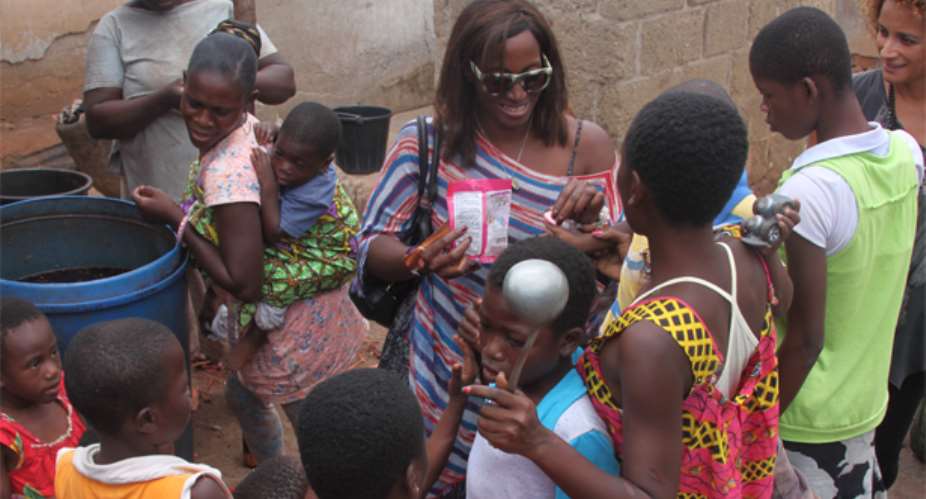Here is Day 3 - 4 from the BBALP trip. The team visited the Kente Weaving market in Bonwire and the Adinkra village. They also gave away some candies to the kids at both places. Below are a few images from the markets. Please read the Editorial note below and take the words you need. You need necessarily need to use everything.
Editor's Note: Day 3 to Day 4 of the BBALP tour to Ghana saw us travel by road from Accra to Kumasi. It was a 5 hour drive through some traffic, hilly roads and a really cool country side. We were totally surrounded by so much vegetation and mountain views during the road trip that we couldn't afford to miss all the nature right around us. On Day 4, we visited Bonwire the Kente weaving village inKumasi and the Adinkra village in Ntonfo to learn more about the fabrics, the process of making both materials, play with the kids and to also grab a few pieces. One of Ghana's and Africa's most cherished fabrics in the world is the Kente Cloth. The Kente cloth has its origin with the Ashanti Kingdom in Ghana, and it is a fabric that has over the years, been adopted by people in Ivory Coastand many other West African countries. Kente is silk mixed with silk cotton fabric and cotton fabric made of interwoven cloth strips. The designs are made by local tailors who weave the Kente cloth using a traditional mechanized system of weaving. Depending on the design and how many materials are used for a particular item, it could take an average of 3 days or more to complete 1 fabric which is why the Kente cloth is 1 of the most cherished fabrics in Africa. 'It's a cloth for the royals,' says John Hutchison our tour guide. Below are a few pictures we took from the weaving market -
For the Adinkra textile, we were given an exclusive guide through the process of making Adinkra 'the old fashion way'. Our guide this time was Peter who has being an Adinkra maker for over 10 years.
"According to history, Adinkra are visual symbols, originally created by the Akan, that represent concepts or aphorisms. Adinkra are used extensively in fabrics, pottery, logos and advertising. The symbols have a decorative function but also represent objects that encapsulate evocative messages that convey traditional wisdom, aspects of life or the environment. There are many different symbols with distinct meanings, often linked with proverbs."
After visiting the Kente weaving village in Kumasi and the Adinkra village in Ntonfo, our last duties for the day, included us attending the Funerals of 2 of the Asante Chiefs. We got a chance to meet the Paramount Chief of Kokofu Barima Offe Akwasi Gyiasio II. 'Kokofu is the community where the BBALP library is located'. Below is a shot we got of Bisila Bokoko alongside Barima Offe Akwasi Gyiasio II in company of Maria Angeles Toichoa, Carola Moldado and Arinze Nwokolo.
 BBALP ADINKRA4
BBALP ADINKRA4
 BBALP KENTE2
BBALP KENTE2
 BBALP ADINKRA TOOLS
BBALP ADINKRA TOOLS
 BBALP ADINKRA
BBALP ADINKRA
 BBALP ADINKRA1
BBALP ADINKRA1
 BBALP ADINKRA2
BBALP ADINKRA2
 BBALP ADINKRA3
BBALP ADINKRA3
 BBALP ADINKRA5
BBALP ADINKRA5
 BBALP BISILA GIVING SOME CANDIES TO THE KIDS
BBALP BISILA GIVING SOME CANDIES TO THE KIDS
 BBALP KENTE MACHINE1
BBALP KENTE MACHINE1
 BBALP KENTE1
BBALP KENTE1
 BBALP BISILA WTH THE PARAMOUNT CHIEF OF KOKOFU
BBALP BISILA WTH THE PARAMOUNT CHIEF OF KOKOFU
 BISILA FEATURED IMAGE
BISILA FEATURED IMAGE





 We’ll no longer tolerate your empty, unwarranted attacks – TUC blasts Prof Adei
We’ll no longer tolerate your empty, unwarranted attacks – TUC blasts Prof Adei
 Bawumia donates GHc200,000 to support Madina fire victims
Bawumia donates GHc200,000 to support Madina fire victims
 IMF to disburse US$360million third tranche to Ghana without creditors MoU
IMF to disburse US$360million third tranche to Ghana without creditors MoU
 Truck owner share insights into train collision incident
Truck owner share insights into train collision incident
 Paramount chief of Bassare Traditional Area passes on
Paramount chief of Bassare Traditional Area passes on
 Two teachers in court over alleged illegal possession of BECE papers
Two teachers in court over alleged illegal possession of BECE papers
 Sunyani: Victim allegedly shot by traditional warriors appeals for justice
Sunyani: Victim allegedly shot by traditional warriors appeals for justice
 Mahama vows to scrap teacher licensure exams, review Free SHS policy
Mahama vows to scrap teacher licensure exams, review Free SHS policy
 Government will replace burnt Madina shops with a new three-story, 120-store fac...
Government will replace burnt Madina shops with a new three-story, 120-store fac...
